CHEVROLET BLAZER 1998 2.G Owners Manual
Manufacturer: CHEVROLET, Model Year: 1998, Model line: BLAZER, Model: CHEVROLET BLAZER 1998 2.GPages: 416, PDF Size: 22.4 MB
Page 251 of 416
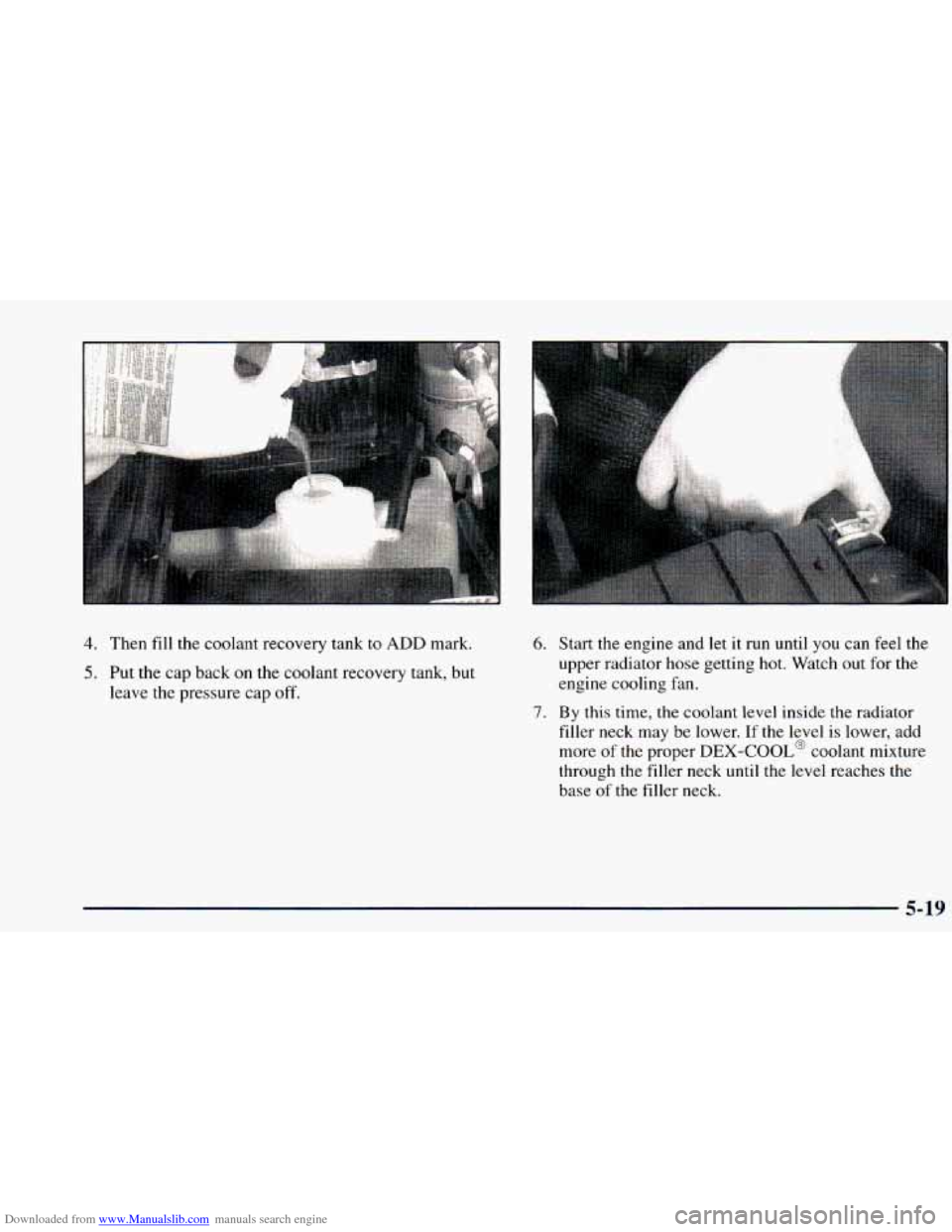
Downloaded from www.Manualslib.com manuals search engine 4. Then fill the coolant recovery tank to ADD mark.
5. Put the cap back on the coolant recovery tank, but
leave the pressure cap off.
6.
7.
Start the engine and let it run until you can feel the
upper radiator hose getting hot. Watch out for the
engine cooling fan.
By this time, the coolant level inside the radiator
filler neck may be lower. If the level is lower, add
more of the proper
DEX-COOL@ coolant mixture
through the filler neck
until the level reaches the
base
of the filler neck.
5-19
Page 252 of 416
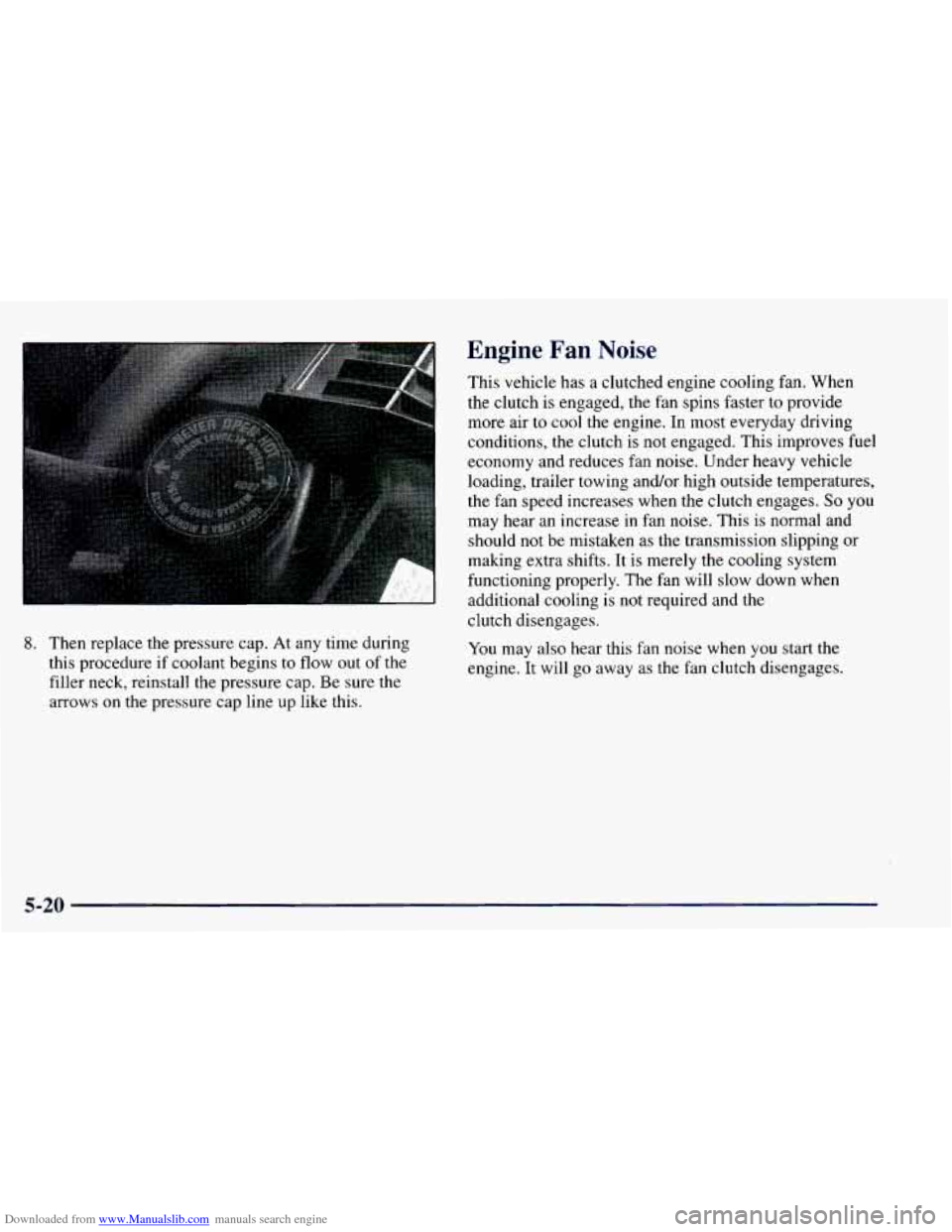
Downloaded from www.Manualslib.com manuals search engine 8. Then replace the pressure cap. At any time during
this procedure if coolant begins to flow out of the
filler neck, reinstall the pressure cap. Be sure the
arrows on the pressure cap line
up like this.
Engine Fan Noise
This vehicle has a clutched engine cooling fan. When
the clutch is engaged, the fan spins faster
to provide
more air to cool the engine.
In most everyday driving
conditions, the clutch is not engaged. This improves fuel
economy and reduces fan noise. Under heavy vehicle
loading, trailer towing and/or high outside temperatures,
the fan speed increases when the clutch engages.
So you
may hear an increase
in fan noise. This is normal and
should
not be mistaken as the transmission slipping or
making extra shifts. It is merely the cooling system
functioning properly. The fan will slow down when
additional cooling is
not required and the
clutch disengages.
You may also hear this fan noise when you start the
engine. It will go away
as the fan clutch disengages.
5-20
Page 253 of 416
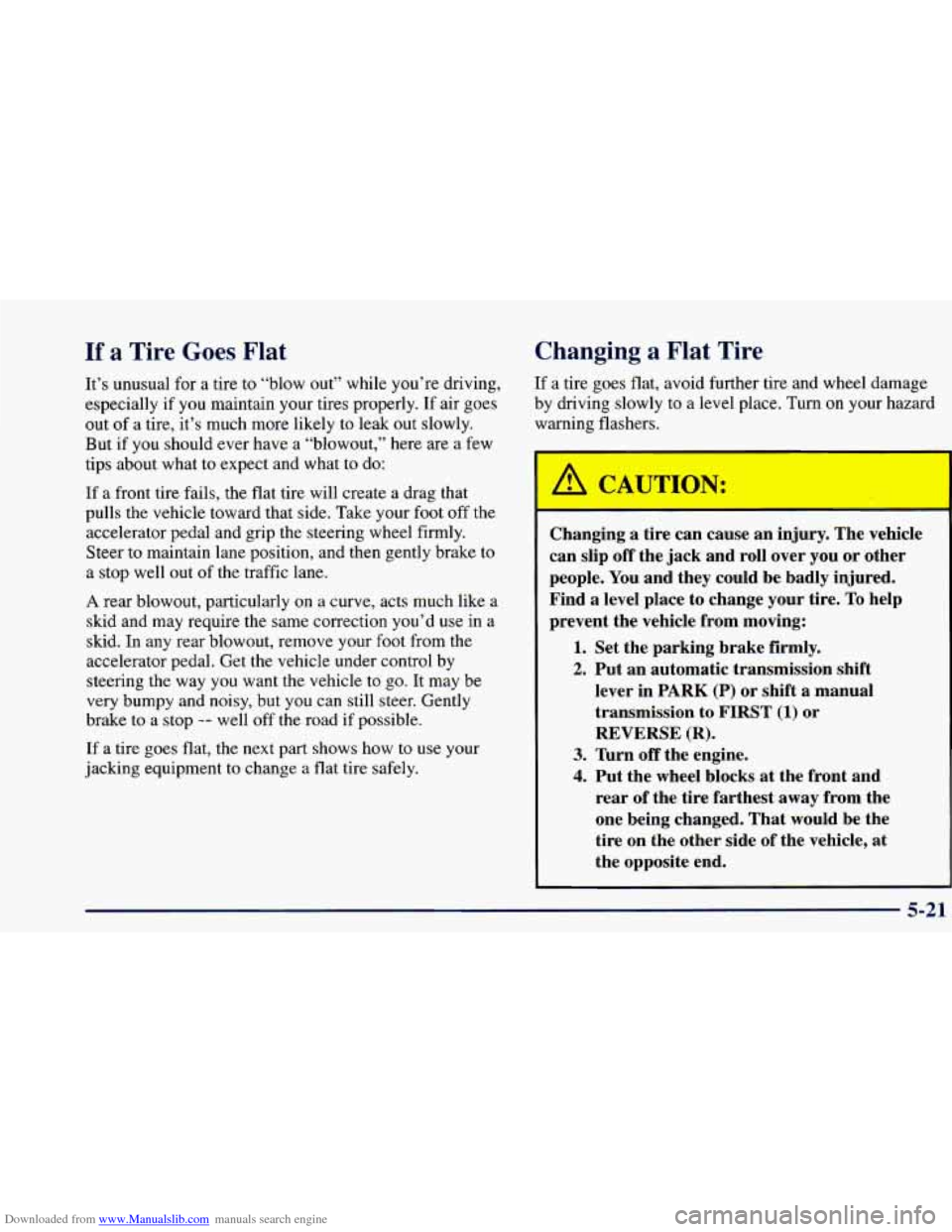
Downloaded from www.Manualslib.com manuals search engine If a Tire Goes Flat
It’s unusual for a tire to “blow out” while you’re driving,
especially if you maintain your tires properly. If air goes
out of
a tire, it’s much more likely to leak out slowly.
But if you should ever have a “blowout,” here
are a few
tips about what to expect and what to do:
If a front tire fails, the flat tire will create a drag that
pulls the vehicle toward that side. Take your foot off the
accelerator pedal and grip the steering wheel firmly.
Steer to maintain lane position, and then gently brake to
a stop well out
of the traffic lane.
H rear blowout, particularly on a curve, acts much like a
skid and may require the same correction you’d use in a
skid. In any rear blowout, remove your foot from the
accelerator pedal. Get the vehicle under control
by
steering the way you want the vehicle to go. It may be
very bumpy and noisy, but you can still steer. Gently
brake to a stop
-- well off the road if possible.
If a tire goes flat, the
next part shows how to use your
jacking equipment to change
a flat tire safely.
Changing a Flat Tire
If a tire goes flat, avoid further tire and wheel damage
by driving slowly to a level place.
Turn on your hazard
warning flashers.
Changing a tire can cause an injury, The vehicle
can slip
off the jack and roll over you or other
people.
You and they could be badly injured.
Find
a level place to change your tire. To help
prevent the vehicle from moving:
1. Set the parking brake firmly.
2. Put an automatic transmission shift
lever in PARK
(P) or shift a manual
transmission
to FIRST (1) or
REVERSE (R).
3. Thrn off the engine.
4. Put the wheel blocks at the front and
rear of the tire farthest away from the
one being changed. That would
be the
tire on the other side of the vehicle, at
the opposite end.
5-21
Page 254 of 416
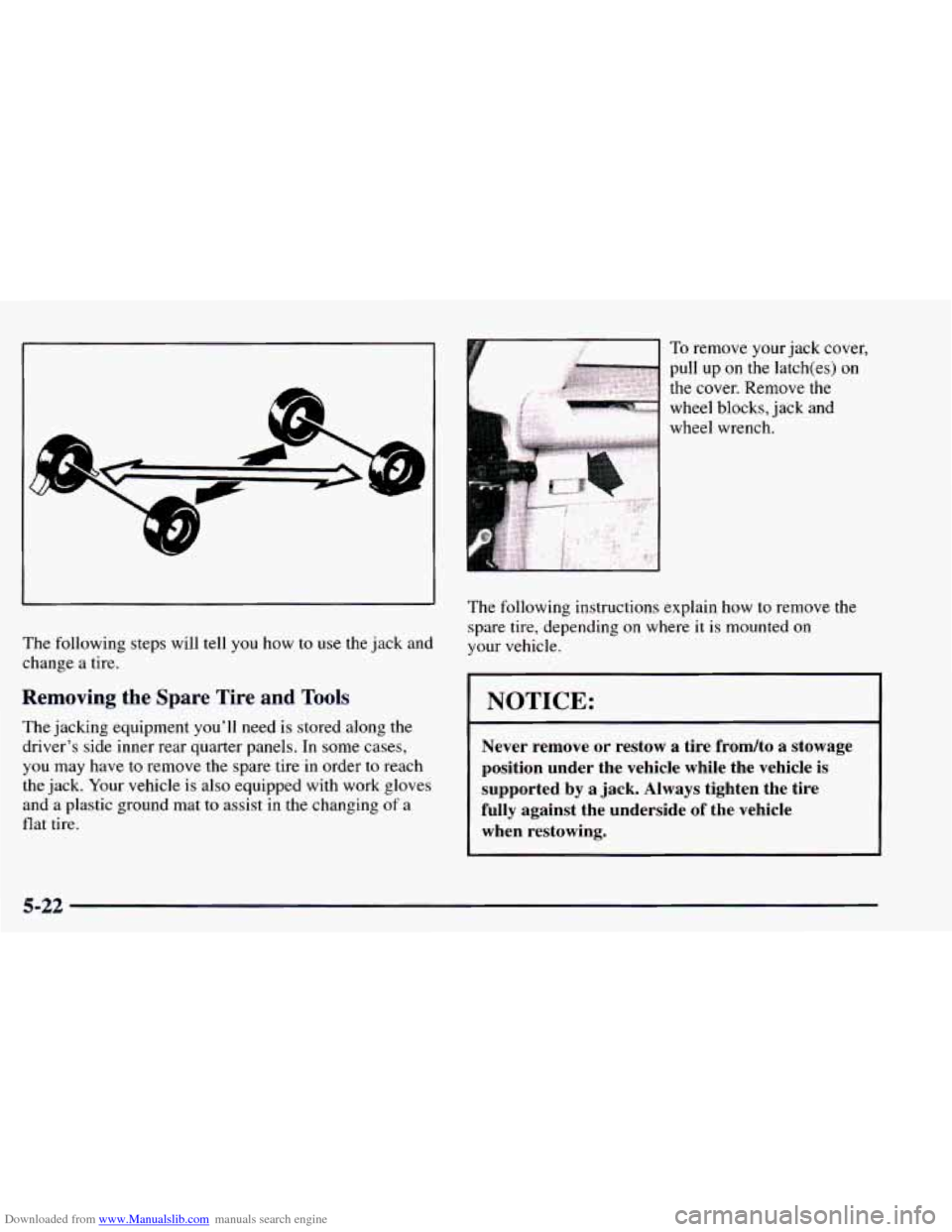
Downloaded from www.Manualslib.com manuals search engine The following steps will tell you how to use the jack and
change a tire.
Removing the Spare Tire and Tools
The jacking equipment you’ll need is stored along the
driver’s side inner rear quarter panels.
In some cases,
you may have to remove the spare tire in order to reach
the jack. Your vehicle is
also equipped with work gloves
and a plastic ground mat
to assist in the changing of a
flat tire. The following instructions explain how
to remove the
spare tire, depending on where
it is mounted on
your vehicle.
I NOTICE:
Never remove or restow a tire frondto a stowage
position under the vehicle while the vehicle is supported
by a jack. Always tighten the tire
fully against the underside of the vehicle
when restowing.
5-22
Page 255 of 416
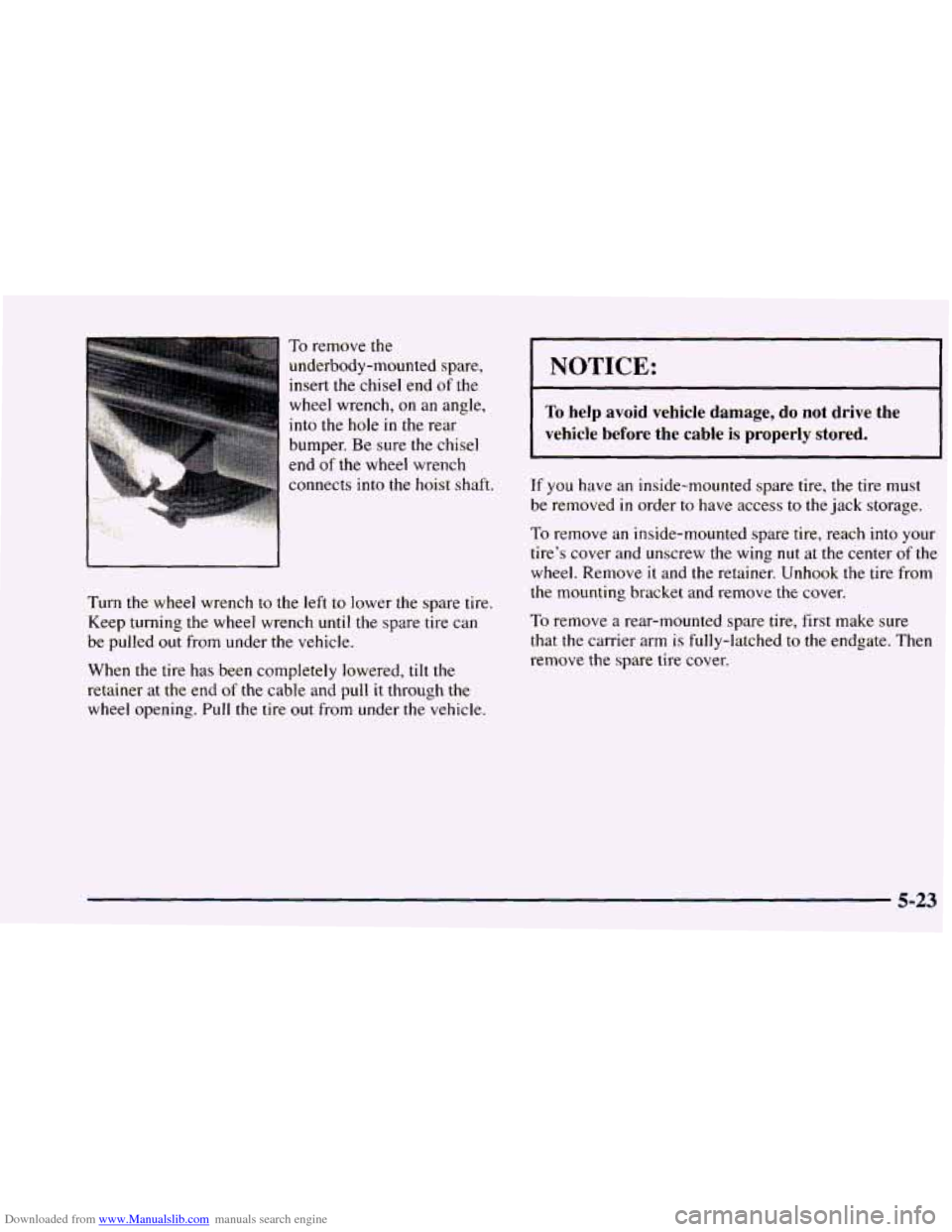
Downloaded from www.Manualslib.com manuals search engine To remove the
underbody-mounted spare,
insert the chisel end of the
wheel wrench,
on an angle,
into the hole
in the rear
bumper. Be sure the chisel
end
of the wheel wrench
connects into the hoist shaft.
Turn the wheel wrench to the left to lower the spare tire.
Keep turning the wheel wrench until the spare tire can
be pulled
out from under the vehicle.
When the tire
has been completely lowered, tilt the
retainer
at the end of the cable and pull it through the
wheel opening.
Pull the tire out from under the vehicle.
I NOTICE:
- ~~
To help avoid vehicle damage, do not drive the
vehicle before the cable
is properly stored.
If you have an inside-mounted spare tire, the tire must
be removed
in order to have access to the jack storage.
10 remove an inside-mounted spare tire, reach into your
tire’s cover and unscrew the wing nut at the center
of the
wheel. Remove
it and the retainer. Unhook the tire from
the mounting bracket and remove the cover.
To remove a rear-mounted spare tire, first make sure
that the carrier arm is fully-latched
to the endgate. Then
remove the spare tire cover.
5-23
Page 256 of 416
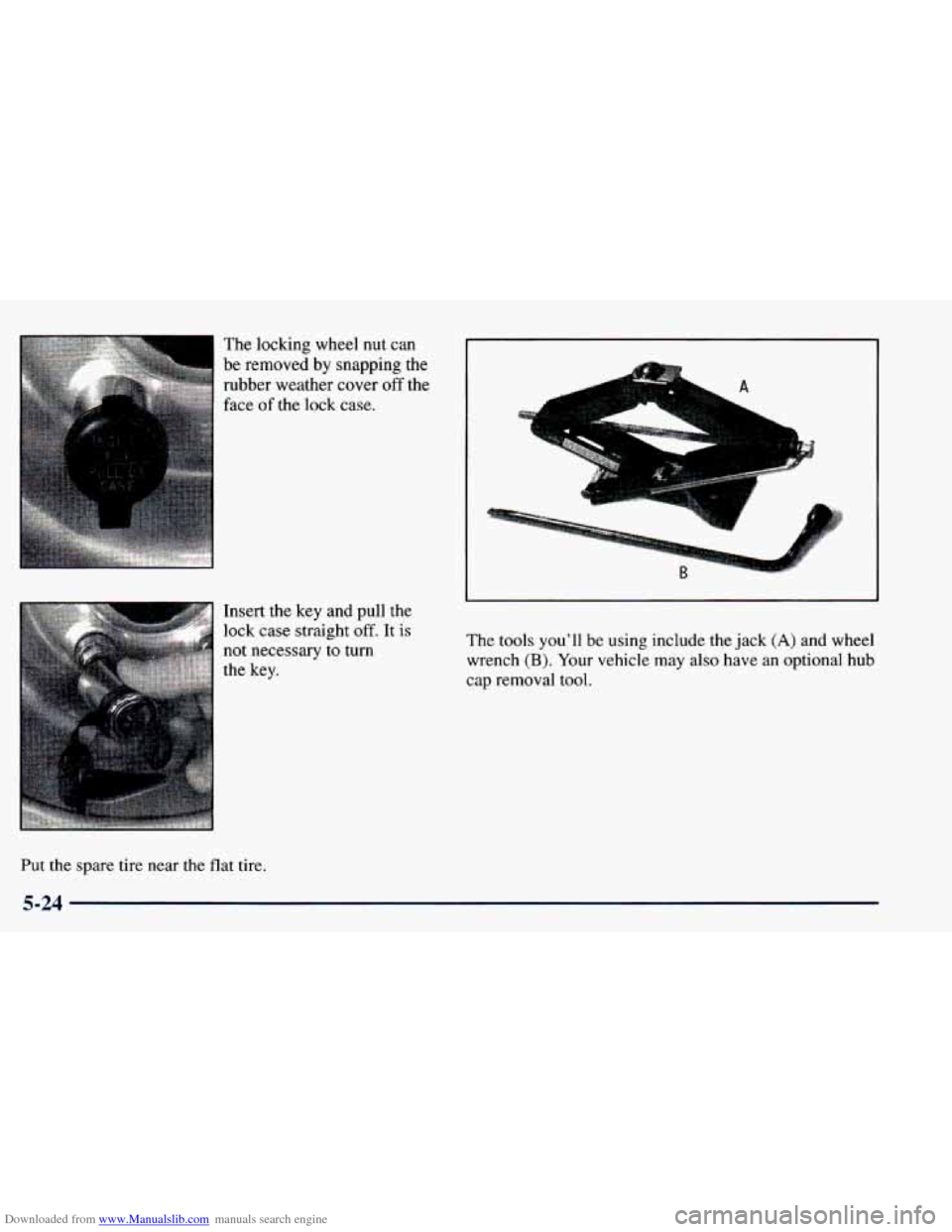
Downloaded from www.Manualslib.com manuals search engine The locking wheel nut can
be removed by snapping
the
rubber weather cover off the
' face of the lock case.
Insert the key and pull the
lock case straight off. It is
not necessary to turn
the key. The
tools you'll be using include the jack (A) and wheel
wrench
(B). Your vehicle may also have an optional hub
cap removal tool.
Put
the spare tire near the flat tire.
5-24
Page 257 of 416
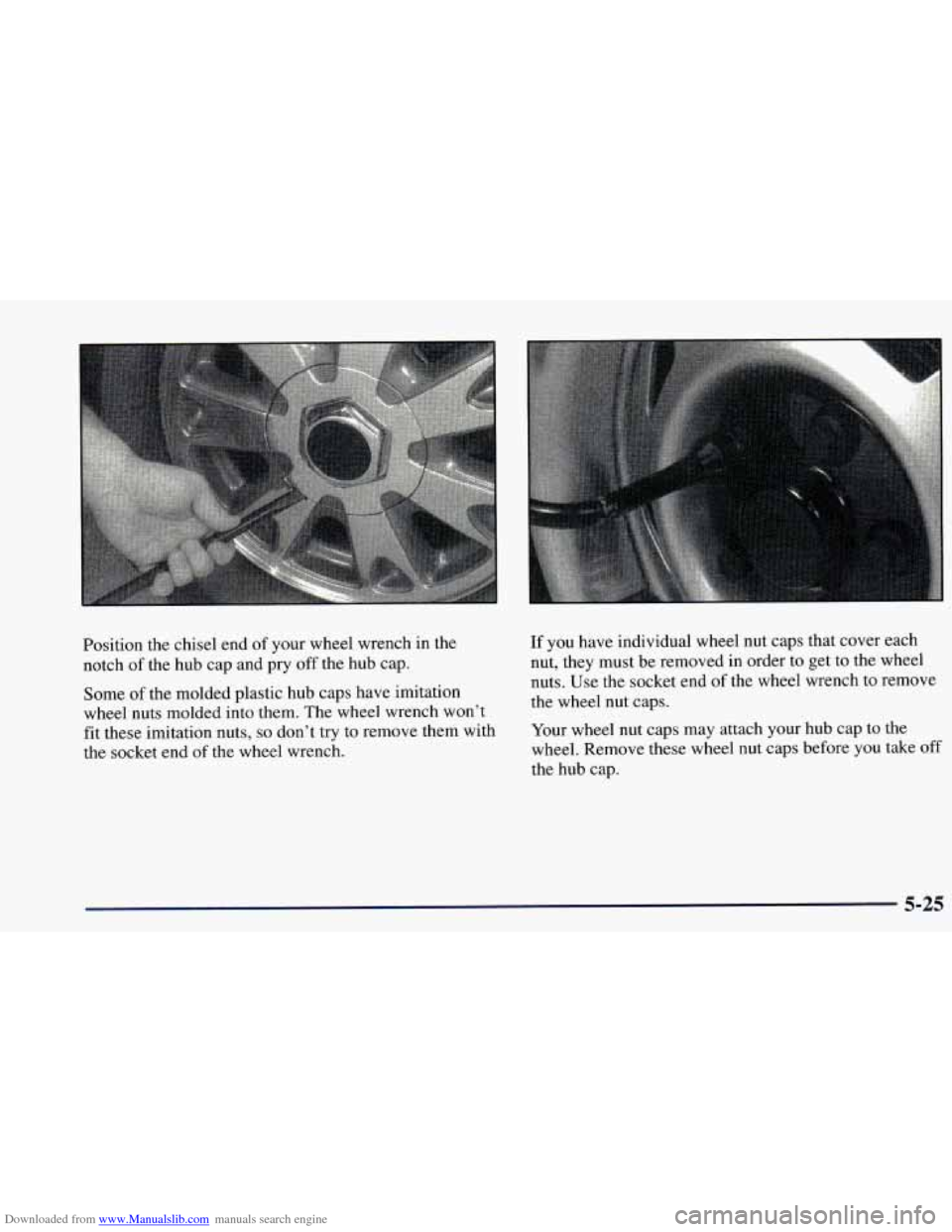
Downloaded from www.Manualslib.com manuals search engine Position the chisel end of your wheel wrench in the
notch
of the hub cap and pry off the hub cap.
Some
of the molded plastic hub caps have imitation
wheel nuts molded into them. The wheel wrench won’t
fit these imitation nuts,
so don’t try to remove them with
the socket end
of the wheel wrench.
If you have individual wheel nut caps that cover each
nut, they must
be removed in order to get to the wheel
nuts. Use the socket end
of the wheel wrench to remove
the wheel nut caps.
Your wheel nut caps may attach your hub cap to the
wheel. Remove these wheel nut caps before you take off
the hub cap.
5-25
Page 258 of 416
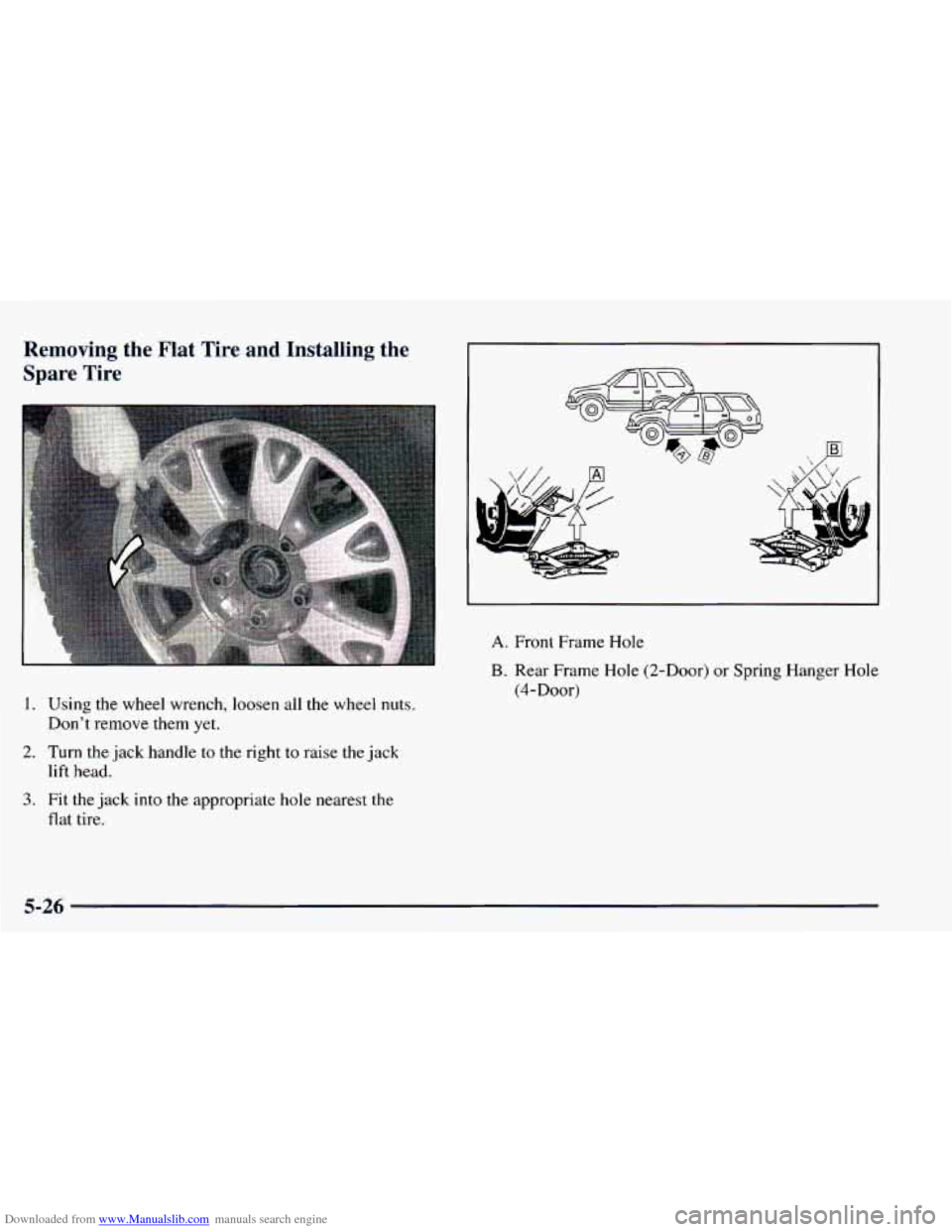
Downloaded from www.Manualslib.com manuals search engine Removing the Flat Tire and Installing the
Spare Tire
1. Using the wheel wrench, loosen all the wheel nuts.
Don’t remove them yet.
2.
Turn the jack handle to the right to raise the jack
lift head.
3. Fit the jack into the appropriate hole nearest the
flat tire.
A. Front Frame Hole
B. Rear Frame Hole (2-Door) or Spring Hanger Hole
(4-Door)
5-26
Page 259 of 416
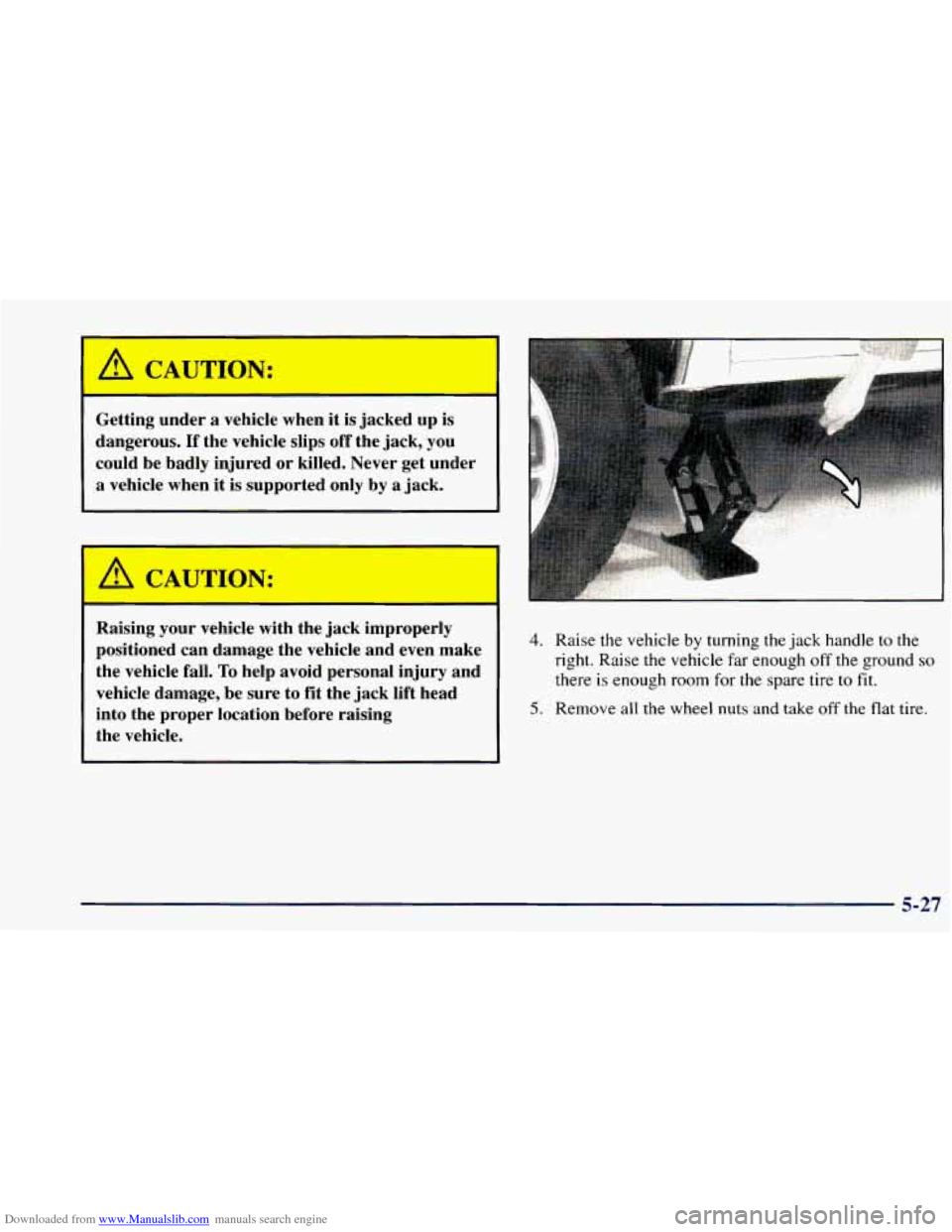
Downloaded from www.Manualslib.com manuals search engine Getting under a vehicle when it is jacked up is
dangerous.
If the vehicle slips off the jack, you
could be badly injured
or killed. Never get under
a vehicle when it is supported only by a jack.
r-
Raising your vehicle with the jack improperly
positioned can damage the vehicle and even make
the vehicle fall.
To help avoid personal injury and
vehicle damage, be sure to fit the jack lift head
into the proper location before raising
l the vehicle.
4. Raise the vehicle by turning the jack handle to the
right. Raise the vehicle far enough
off the ground so
there is enough room for the spare tire to fit.
5. Remove all the wheel nuts and take off the flat tire.
5-27
Page 260 of 416
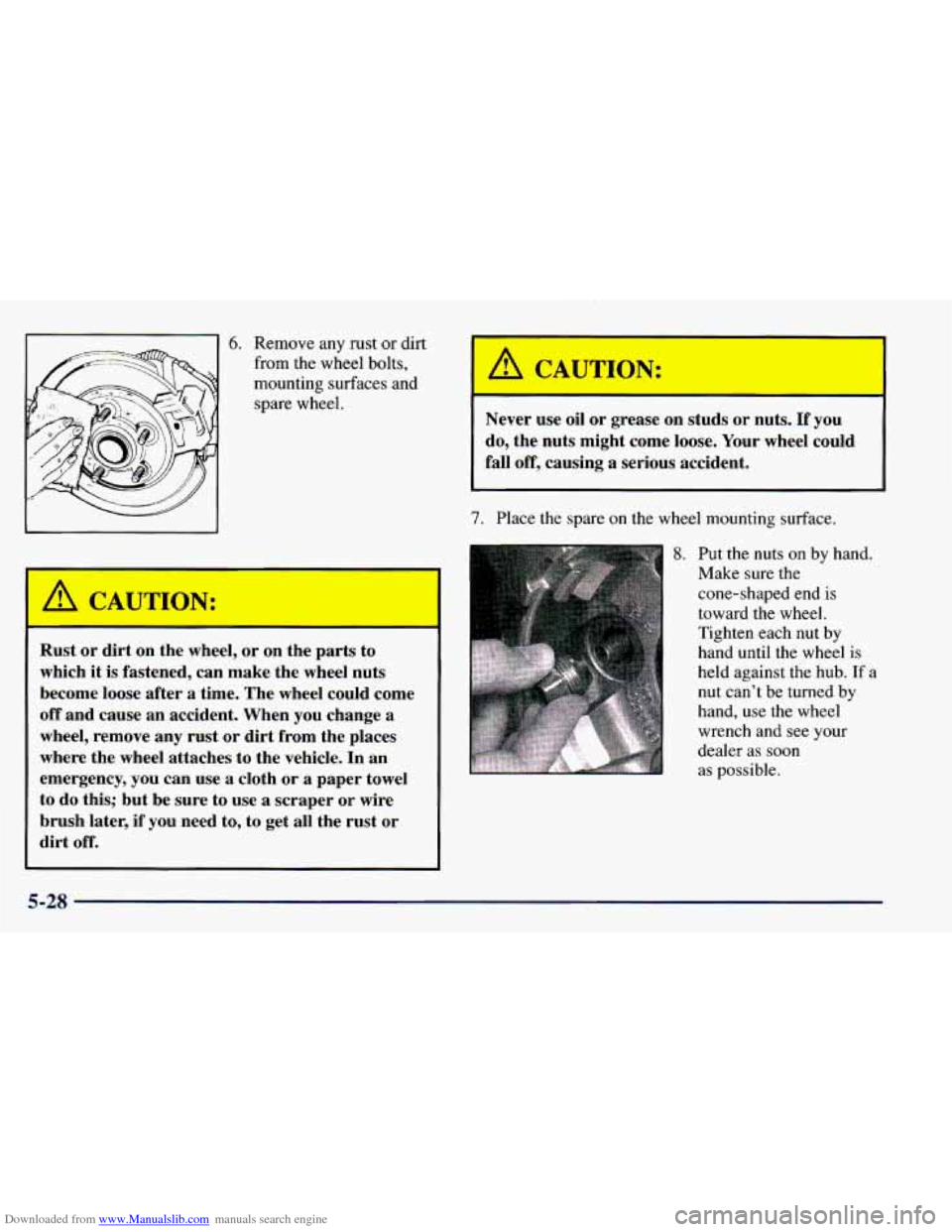
Downloaded from www.Manualslib.com manuals search engine 6. Remove any rust or dirt
from the wheel bolts,
mounting surfaces and spare wheel.
1st or dirt on the
w ,el, or on the parts to
which it is fastened, can make the wheel nuts
become loose after a time. The wheel could come
off and cause an accident. When you change a
wheel, remove any rust or dirt from the places
where the wheel attaches to the vehicle. In an
emergency, you can use a cloth
or a paper towel
to
do this; but be sure to use a scraper or wire
brush later, if you need to, to get all the rust or
dirt
off.
I
Never use oil or grease on studs or nuts. If you
do, the nuts might come loose. Your wheel could
fall
off, causing a serious accident.
7. Place the spare on the wheel mounting surface.
Put the nuts
on by hand.
Make sure the
cone-shaped end
is
toward the wheel.
Tighten each nut by hand until the wheel
is
held against the hub. If a
nut can’t be turned by
hand, use the wheel
wrench and see your
dealer as soon
as possible.
5-28